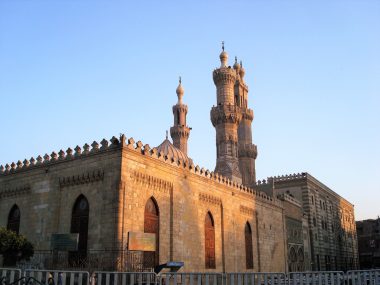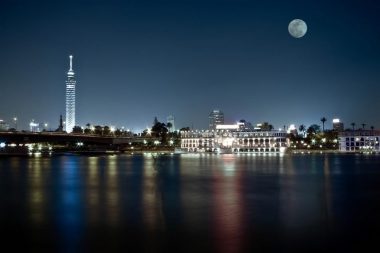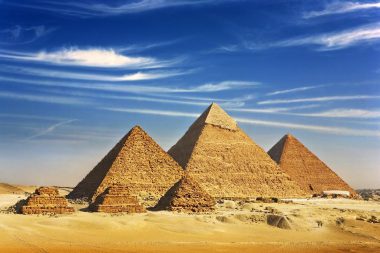Cairo, the largest city on the African continent, is said to look like an unwashed and disheveled girl to its visitors on a first visit. But anyone who has become accustomed to the maze of streets and the noise level in the bazaar understands why Cairo is referred to as the “mother of all cities”. Because this “disheveled girl” has many faces and here and there the lady is serious and graceful. For more than a thousand years, the Arab world has called the metropolis of millions “Al-Qahira” – the “victorious”. And so Cairo endures the daily traffic jams on the roads and the incessant onslaught of new citizens with astonishing composure.
An abundance of Islamic monuments in the centre
According to the history books, it was in 969 that the Fatimids, an Ismaili dynasty, advanced into Egypt and brought the region under their rule. A certain caliph al-Muizz is said to have founded Cairo. In the period that followed, walls enclosed the city, and three of the once sixty gates have been preserved: Bab-el-Futuh and Bab-en-Nasr on the northern periphery, and Bab-es-Suwela in the south. Today, they serve tourists as photogenic testimonies to a bygone era. Cairo, however, became a World Heritage Site more because of the abundance of Islamic monuments that are crowded into an area of only four square kilometers in the city center.
El-Azhar Mosque – Site of Sunni Doctrine

The El-Azhar mosque has also been preserved from the founding period of Cairo. It is one of the oldest Islamic places of worship in the world and is a showpiece in the city of a thousand minarets. The mosque has always had the status of an influential institution in Egyptian society, because it saw itself as a stronghold of Islamic teaching and a university for the study of Sunni theology. Cairo has numerous sights, and if you stroll north through the narrow street canyons as a visitor to this city, you will involuntarily come to one of the most magnificent legacies of the so-called Mameluke architecture. The extensive mausoleum is said to have been built in 1285 in just 13 months. The main hall is richly decorated with mosaics and valuable stucco and was once extended by a hospital, of which there is only a ruin today.
Beautiful residential palaces from the 14th century

It was thanks to the German Archaeological Institute that the historic fountain house with Koran school, the Abder-Rahman Katkhuda, presents itself in its old glory. The two-storey pavilion with its arcades is a real eye-catcher and forms a unit with the Beit Emir Bestak opposite, one of the most beautiful residential palaces from the 14th century. Today, this museum brings the history of Cairo closer to visitors. A walk through the old quarter of this metropolis is like a journey through time. With a taxi and a little patience in the everyday traffic chaos of Cairo, you can get to Zamalek and thus to the modern district of the city. The embassies of numerous countries have established themselves here. Mostly in villas from the Belle Epoque period. Here, in the north of the Nile island of Gezira, the members of the “upper ten thousand” of this city are also at home.
The history of Egypt comes alive in the museum
Of course, every visitor to Cairo should be guided by the Egyptian Museum. It sees itself as a kind of “treasure chest” of the country and as a symbol of the lost era of the pharaohs. No fewer than 150,000 exhibits, most of which were snatched from the barren Egyptian soil on the Nile, are housed in this museum. Here the history of the country comes alive, and it is not only the grave goods of the legendary young King Tutankhamun that are worth visiting. The extensive complex was opened in 1902, and the hundred halls extend over two floors. This museum is unparalleled in the world. Under the presidency of Anwar Sadat, the Hall of the Royal Mummies was closed for four years, but is now open again to interested parties from all over the world.
The missing nose of the Sphinx in the desert sand

Cairo is also the starting point for cruises on the Nile and discovery trips to the unique archaeological sites in the Valley of the Kings. However, the great Sphinx with the Great Pyramid of Cheops rises out of the sand of the Egyptian desert virtually on the doorstep of the big city. This ensemble was probably built in the fourth dynasty under the rule of the Khafre dynasty around 2500 BC. It is located about twenty kilometers south of the center of Cairo and can be reached either by taxi or by metro. If you put yourself in the care of a guide at the destination, you will probably also learn why the Sphinx is missing its nose. Responsible for this misdeed is said to have been a sheikh named Mohammed Saim el-Dar in 1378.
Winding alleys and many merchants in the bazaar
Wondrous and superfluous things are offered in the Grand Bazaar of Cairo. He calls himself Khan-el-Khalili and it is said that you can get lost in his winding alleys from time to time. The bazaar is 1,500 meters long, and there are said to have been more than 12,000 shops here as early as the Middle Ages. Mainly souvenirs, jewellery and antiques are offered by the dealers here, but not everything that you think is an original turns out to be a cheap copy at home. If you want to experience authentic Cairo and a touch of the Orient, you should sit down in one of the countless parlours, try the spicy Arabic coffee and watch the locals smoking their hookah.


